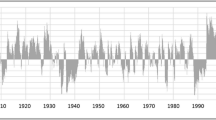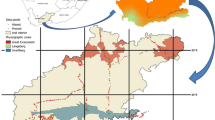Abstract
The relation between the occurrence of riverine wetlands in floodplains along a humid to semiarid climatic continuum was studied in two regions. The first included 36 mid-reach streams from Colorado to Iowa, USA, a region with a broad range of PET ratios (potential evapotranspiration/precipitation) from 0.70 to 1.75. The second region included 16 headwater streams in eastern North Carolina with PET ratios ranging from 0.67 to 0.83. Wetland boundaries were identified in the field along transects perpendicular to the floodplain. The width of jurisdictional wetlands was compared with flood-prone width (FPW) and expressed as a percent. An increase in PET ratio corresponded to an exponential decrease in the percentage of the FPW that is wetland. Soil texture, duration of overbank flow, and stream order did not correlate with percentage of FPW that was wetland. Streams with a PET ratio greater than 0.98 did not have wetlands associated with them. Greater channel cross-sectional areas correlated positively with greater wetland widths in both study regions. Overbank flow did not appear to contribute to wetland prevalence. Supplemental ground-water sources, however, as indicated by greater base flows, could not be ruled out as sources contributing to wetland occurrence.
Similar content being viewed by others
Literature Cited
Abrams, M. D. 1985. Age-diameter relationships of Quercus species in relation to edaphie factors in gallery forests in Northeast Kansas. Forest Ecology and Management 13:181–193.
Auble, G. T., J. M. Friedman, and M. L. Scott. 1994. Relating riparian vegetation to present and future stream flows. Ecological Applications 4:544–554.
Brinson, M. M. and A. I. Malvarez 2002. Temperate freshwater wetlands: types, status, and threats. Environmental Conservation 29:115–133.
Burke, M. A. and W. L. Nutter. 1995. Channel morphology evolution and riverine wetland hydrology in the Georgia piedmont. p. 463–475. In K. L., Campbell (ed.) Versatility of wetlands in the agricultural landscape. American Society of Agricultural Engineers. Tampa, FL, USA.
Collins, S. L., P. G. Risser, and E. L., Rice. 1981. Ordination and classification of mature bottomland forests in North Central Oklahoma. Bulletin of the Torrey Botanical Club 108:152–165.
Comerford, N. B., A., Jerez, A. A. Freitas, and J. Montgomery. 1996. Soil water-table, reducing conditions, and hydrologie regime in a Florida flatwood landscape. Soil Science 161:194–199.
Earthinfo, 1995a. NCDC Summary of the Day, Boulder, CO, USA. CD-ROM.
Earthinfo, 1995b. USGS Daily Values. Boulder, CO, USA. CD-ROM.
Environmental Laboratory. 1987. Corps of Engineers wetlands delineation manual. U.S. Army Engineer Waterways Experiment Station. Vicksburg, MS. USA. Technical report. Y-87-1.
Fetter, C. W., Jr. 1994. Applied Hydrogeology, third edition. Prentice Hall. Upper Saddle River, NJ, USA.
Friedman, J. M. and G. T. Auble. 2002. Floods, flood control, and bottomland vegetation. p. 219–237. In E. Wohl (ed.) Inland Flood Hazards: Human, Riparian, and Aquatic Communities. Cambridge University Press, Cambridge, England.
Gerlach, A. C. (ed). 1970. Mean annual freeze-free period. Map 1: 17000000. p. 417. In: The national atlas of the United States of America. U.S. Geological Survey. Washington, DC, USA.
GretagMacbeth. 1996. Munsell soil color charts. GretagMacbeth, New Windsor, NY, USA.
Hewlett, J. D. 1961a. Soil moisture as a source of baseflow from steep mountain watersheds. USDA Forest Service. Asheville, NC, USA, Station paper no. 132.
Hewlett, J. D. (1961b. Watershed management. p. 61–66. In Annual report for 1961. USDA Forest Service, Southeastern Forest Experimental Station. Asheville, NC, USA.
Holdridge, L. R., W. C. Grenke, W. H. Hatheway, T. Liang, and J. A. Tosi, Jr. 1971. Forest Environments in Tropical Life Zones: a Pilot Study. Pergamon Press, Elmsford, NY, USA.
Hupp, C. R. and W. R. Osterkamp. 1996. Riparian vegetation and fluvial geomorphic processes. Geomorphology 14:277–295.
Hupp, C. R. 2000 Hydrology, geomorphology and vegetation of Coastal Plain rivers in the south-eastern USA. Hydrological Processes 14:2991–3010.
Hunt, C. B. 1967. Physiography of the United States. W. H. Freeman and Co. San Francisco, CA, USA.
Hunt, C. B. 1977. Surficial geology. Map 1∶7500000. United States Geological Survey, Reston, VA, USA.
Hunt, R. J., J. F. Walker, and D. P. Krabbenhoft. 1999. Characterizing hydrology and the importance of ground-water discharge in natural and constructed wetlands. Wetlands 19:458–472.
Küchler, A. W. 1967. Vegetation Mapping. Map 1∶7500000. Ronald Press, New York, NY, USA.
Leopold, L. B. 1994. A View of the River. Harvard University Press, Cambridge, MA, USA.
Leopold, L. B., M. G. Wolman, and J. P. Miller. 1964. Fluvial Processes in Geomorphology. W. H. Freeman and Co., San Francisco, CA, USA.
Lugo, A. E., S. L. Brown, R. Dodson, T. S. Smith, and H.H. Shugart. 1999. The Holdridge life zones of the conterminous United States in relation to ecosystem mapping. Journal of Biogeography 26:1025–1038.
NRC (National Research Council). 2002. Riparian Areas: Functions and Strategies for Management. National Academy Press. Washington, DC, USA.
NWS (National Weather Service). 1997. Flood Forccasting. www.nws.noaa.gov.
Reed, P. B. 1988. National list of plant species that occur in wetlands: 1988 national summary. U.S. Fish and Wildlife Service, Washington, DC, USA. Biological Report 88(24).
Rheinhardt, R. D., M. C. Rheinhardt, M. M. Brinson, and K. Faser. 1998. Forested wetlands of low order streams in the Inner Coastal Plain of North Carolina, USA. Wetlands 18:365–378.
Rice, E. L. 1965. Bottomland forests of north-central Oklahoma. Ecology 46:708–714.
Riggs, H. C. and K. D. Harvey. 1990. Temporal and spatial variability of stream flow. p. 81–96. In M. G. Wolman and H. C. Riggs (eds.) Surface Water Hydrology. Geological Society of America, Inc., Boulder, CO, USA.
Rosgen, D. 1996. Applied River Hydrology. Wildland Hydrology, Pagosa Springs, CO, USA.
Shafroth, P. B., G. T. Auble, J. C. Stromberg, and D. T. Patten 1998. Establishment of woody riparian vegetation in relation to annual patterns of stream flow, Bill Williams River, Arizona. Wetlands 18:577–590.
Strahler, A. N. 1957. Quantitative analysis of watershed geomorphology. American Geophysical Union Transactions 38:913–920.
Taylor, J. P., D. B. Webster, and L. M. Smith. 1999. Soil disturbance, flood management, and riparian woody plant establishment in the Rio Grande floodplain. Wetlands 19:372–382.
Thein S. S. 1979. A flow diagram for teaching texture-by-feel analysis. Journal of Agronomic Education 30:54–55.
Thornthwaite, W. C. and B. Holzman. 1942. Measurement of evapotranspiration from land and water surfaces. U.S. Department of Agriculture, Washington, DC, USA. Technical Bulletin No. 817.
Williams, G. P. 1978. Bank-full discharge of rivers. Water Resources Research 14:1141–1154.
Author information
Authors and Affiliations
Rights and permissions
About this article
Cite this article
Kroes, D.E., Brinson, M.M. Occurrence of riverine wetlands on floodplains along a climatic gradient. Wetlands 24, 167–177 (2004). https://doi.org/10.1672/0277-5212(2004)024[0167:OORWOF]2.0.CO;2
Received:
Revised:
Accepted:
Issue Date:
DOI: https://doi.org/10.1672/0277-5212(2004)024[0167:OORWOF]2.0.CO;2




